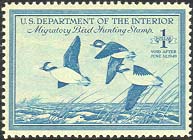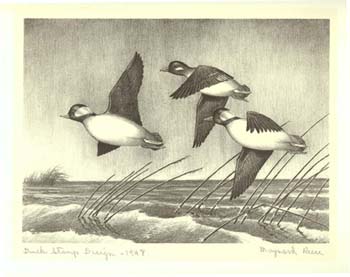

Back to RW15 Back to the Federal Index Home
A LITTLE HISTORY ON THE 15TH (1948-49) DUCK STAMP ARTIST


When Maynard Reece was only 12, he entered a pencil sketch in the 1932 Iowa State Fair. He had been drawing for some time and the fair seemed a good place to test his skills. His entry was a pencil drawing of wildlife. The drawing not only attracted considerable attention but took first prize at the fair. Thus at an early age Mr. Reece established a pattern for his later life as a highly successful wildlife artist.
Maynard Reece was born in 1920 in Arnolds Park, Iowa. The area in which he lived is the famous lake district in the northwest part of the state, near Lake Okoboji and Spirit Lake, scene of the historic Spirit Lake massacre described by Kantor. It was a wonderful area for a young imagination and Mr. Reece often spent time in the outdoors with his sister and two brothers. It was the ideal country for a boy who had an abiding interest in wildlife. He took full advantage of it hunting, fishing and simply watching birds and animals every time he had a chance. It was here that he found the material for his first drawings.
After his success at the state fair, he finished school and emerged ready to test his skills as an artist in the commercial world. For two years, he was employed by the Meredith Publishing Company as an artist. After that he was assistant museum director and staff artist. While he was working at the Museum, much of his time was spent in the field where he collected specimens and data for many of the various state publications on wildlife and the outdoors.
When World War II broke out, he took a leave of absence from the Museum to join the Army. He ended up in the Signal Corps and was stationed in California. There he was able to use his abilities by working as an artist in training aids, doing paintings and artwork of and for the Signal Corps. Later he transferred to a photographic outfit and was sent to Europe. When the war ended in 1946, he returned to the Museum.
It was in this post-war time that he began doing most of his book illustrations. During this period he illustrated the books Waterfowl in Iowa by Jack and Mary Musgrove, published by the Iowa Conservation Commission and Iowa Fish and Fishing by Speaker and Harlan. It was also during this time that he made the design that won the Duck Stamp contest, a painting of Buffleheads Aloft. The painting brought him national recognition. Although it was not the first national attention he had received, it added to a reputation that was growing at a remarkably rapid rate.
In 1951, Mr. Reece resigned from the Museum and began to devote his full efforts to free-lancing. Although his talents would have allowed him to broaden his choice of subjects, he chose to stay exclusively in the wildlife field. He has worded full time as a free-lance artist since that time.
Mr. Reece is married and has two sons.
-------------------------THE ART-------------------------
Buffleheads was painted in watercolor wash and gouache. The print was hand
pulled form a lithograph stone on white Rives heavy paper using black ink. All
prints were hand signed in pencil but not numbered. the image size of the print is 6
3/4" x 9 1/8".
-------------------------THE STAMP-------------------------
Buffleheads...Engraved by the Federal Bureau of Engraving from the original artwork.
Printed in brilliant light blue. The stamp sold for one dollar. Postal
records show 2,127,603 stamps sold. First day of sale was July 1, 1948.
Most of the information contained above is from the book Federal Duck Stamp Story, Fifty Years of Excellence, by Laurence F. Jonson; Alexander & Co. It is used here with permission from the author. For more information on this book, please click here.